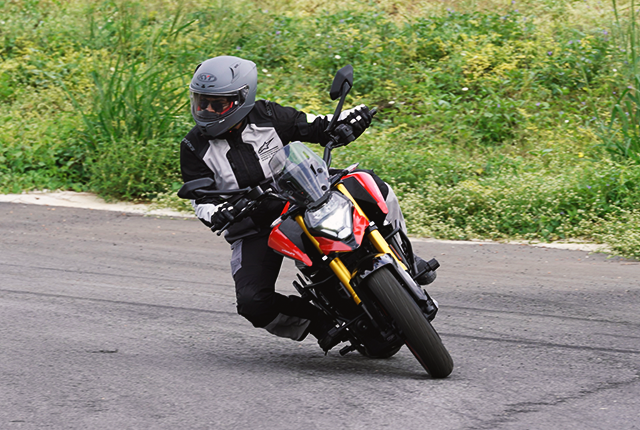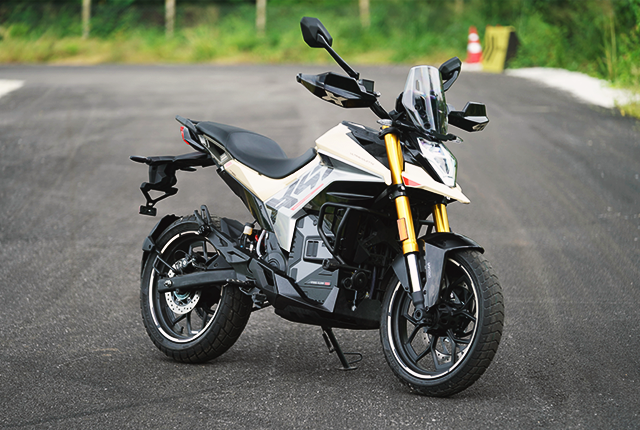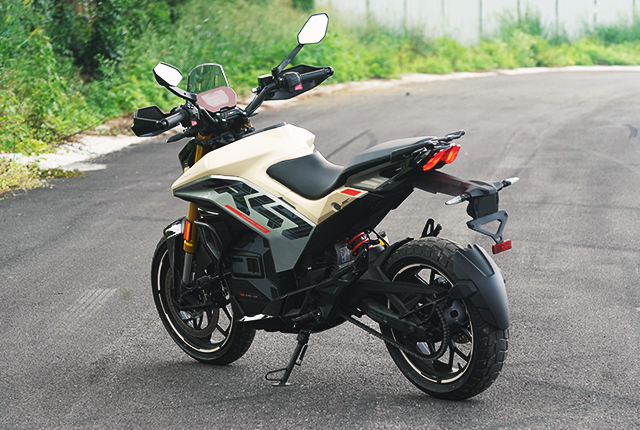
Sporting a name inspired by the hallowed Northrop Grumman X-47B experimental aircraft, the X47 Crossover aims to be the all-round electric solution to Indian roads. Is it Ultraviolette’s best bike yet? We find out
Story: Abhisu Poddar
Photography: Sanjay Raikar
Two months ago, we rode the Ultraviolette F77 Mach 2 Recon with the new Gen3 powertrain update. Thoroughly impressed by the electric bike and the initiative of the team behind it, I just couldn’t help but wish the F77’s fantastic chassis and motor was something we could use more on a regular basis, with its aggressive sportsbike-like posture and suspension setup feeling more at home on butter-smooth asphalt than the real Indian roads which we are all well-acquainted with by now.


And lo! It’s as if Ultraviolette listened to our whispers and shaped them into the X47 Crossover. Positioned as a hybrid between streetbikes and ADVs, it wouldn’t be blasphemous to brand it as an F77 on stilts – the chassis, motor, battery, wheels, brakes, even the cluster and the triple clamp, are all a direct import from the F77. What has really changed, however, is the design, the tech, the tyres, and the suspension tuning – the front end gets a handsome ADV-like makeover, with the F77 headlight now positioned higher, complemented by a beak underneath. The handlebar is now raised and widened, and a single seat now saddles the rider in a more upright, adventure-friendly posture. A brand-new cast-aluminium subframe strengthens the chassis, bracing it for the extra touring weight the optional panniers offered by Ultraviolette can carry. More importantly, the subframe hides underneath unique tricks of technology that Ultraviolette claims to be industry-firsts. More on that later.
Ultraviolette invited us to experience the X47 Crossover on a karting circuit in Bangalore, allowing us to explore the village and highway roads around the track when we were done pushing it to the limit in the performance zone. The X47 Crossover sits about 200-mm off the ground, while maintaining a seat height of 820-mm and a weight of 208 kg. The weight is concentrated down low, and the tall-wide handlebars make the X47 a very easy bike to manoeuvre and manage. The 17-inch wheels are now shod with road-biased all-terrain tyres, aligning with the bike’s ‘jack of all trades’ ethos, and provide plenty of grip on all kinds of terrain.
Performance is familiar territory for the X47, with the same 30 kW/40.2 hp Permanent Magnet AC motor generating 100 Nm of torque at the primary drive. The torque is now multiplied to 610 Nm at the rear wheel, thanks to a larger sprocket. Ultraviolette claims 0-60 km/h time of 2.7 seconds and a 0-100 km/h time of 8.1 seconds, with a top speed of 145 km/h, lower than the F77’s thanks to the larger rear sprocket. Riders get three modes and four levels of traction control. The motor is smooth, offering all the torque when you demand for it from the sensitive throttle, whirring away with a supercharger-like whine. 10 levels of regen allows the rider to control the ‘engine braking’ when coasting off-throttle, with the added advantage of charging the battery. In Ballistic mode, acceleration feels especially lively up to around 80 km/h. The numbers are comparable to 250-cc motorcycles, but the silent, seamless surge makes for a uniquely enjoyable experience.
Not enough words can praise the steel trellis frame. Calling it a scalpel won’t do justice to a bike as tall and brutesque, but it does carve through corners like a scythe. The 41-mm upside-down telescopic forks and the rear monoshock have been tinkered with for longer travel (170-mm) with compression and rebound characteristics that suit its ‘all-road’ intentions. The ride quality is plush, and while the tuning of the dampers make the smaller ruts and bumps on the road felt, the larger ones are dispatched with absolutely no trouble at all. Enthusiastic riders will find the chassis and the suspension setup to be very communicative and cooperative, encouraging the rider to keep on leaning till pegs kiss the road. Off the asphalt, the X47 handles mud stricken unpaved roads with aplomb, however, it’s not a bike that we would go hit the trails with, thanks to its weight and range.
One of the biggest talking points with the X47 is its debut of radar-based rider alerts, offered as standard across all variants. At its core sits a rear-facing radar module, constantly sweeping 200 metres of road behind. It acts as an unseen guardian, flagging blind spots, warning of vehicles rushing past, or even signalling an imminent collision. The alerts appear as subtle lights in the mirrors, backed up by messages on the TFT display. Unlike car systems, this one doesn’t intrude with steering or braking: it merely issues visual warnings, leaving control firmly in the rider’s hands. Though we couldn’t test it on public roads, the demonstration at that karting track showed it working seamlessly.
Adding to the suite, Ultraviolette will also offer a dual-camera dashcam setup, with front and rear units feeding into a dedicated secondary display above the main TFT. Unlike the onboard charger, this system isn’t included with any variant and will only be available as an optional extra.
Similar to the F77, Ultraviolette has two battery options on offer for the X47 Crossover. The base 7.1 kWh “SRB7” promises an IDC range of 211 km, while the one we got to test is the top-range 10.3 kWh “SRB10” that claims an IDC score of 323 km. Realistically, we can see the SRB10 going about 250 km on Glide mode and 120 km on Ballistic mode.
Charging has been made really accessible by introducing four different methods of juicing up – tucked neatly within the new subframe is what Ultraviolette claims to be the world’s most power-dense, air-cooled onboard charger, capable of charging at 1.6 kW. The real convenience here is that you no longer need to lug around a bulky external unit – just a compact, lightweight cable will do. For those who want quicker top-ups, an optional 1.6 kW boost charger can double the charging speed. Riders can also opt to carry a fast-charger brick around, or charge their bikes at Ultraviolette’s 6kW Supernova and 12kW Supernova+ charging stations.
The X47 Crossover will be offered in four variants, with each battery-motor configuration getting two variants. The Original and Original+, priced at Rs 2.49 lakh and Rs 2.99 lakh (ex-showroom) respectively, get the 7.1 kWh “SRB7” battery and a motor putting out 27 kW/36.7 hp and 550Nm. The Recon and the Recon+ variants, priced at Rs 3.49 lakh and Rs 3.99 lakh respectively, get the larger “SRB10” battery and the more powerful motor that we had the opportunity to review. These prices include a Rs 25,000 discount in every variant for the first 5,000 customers. The Original+ and Recon+ variants also get onboard charging, parallel boost charging, and access to UV’s Supernova+ fast charging outlets.
Ultimately, the X47 Crossover stands out as the most ideal motorcycle in Ultraviolette’s lineup. Delivering the same performance levels as the F77 while offering far greater usability on Indian roads, it’s an extension of Ultraviolette’s vision of how the future of electric mobility looks like. That said, familiar drawbacks remain: it is on the heavier side, the fit and finish of the bodywork could use refinement, and the higher-spec variants are still priced at a premium. Even so, this is a more accessible proposition than its predecessors, likely to draw in a wider group of early adopters who were previously hesitant about the F77’s ergonomics and commitment. For Ultraviolette, it’s a strong stopgap before the brand’s true mass-market models arrive next year.
Also Read: Ultraviolette F77 Gen3 Powertrain Review


Leave a Reply